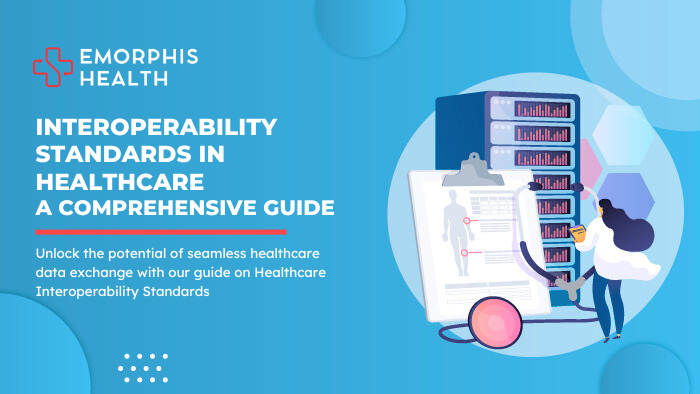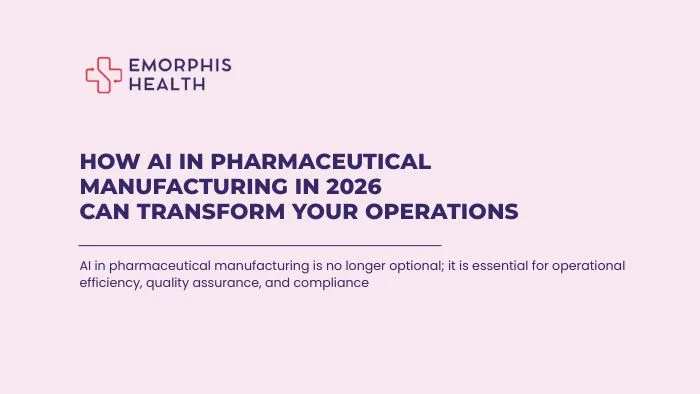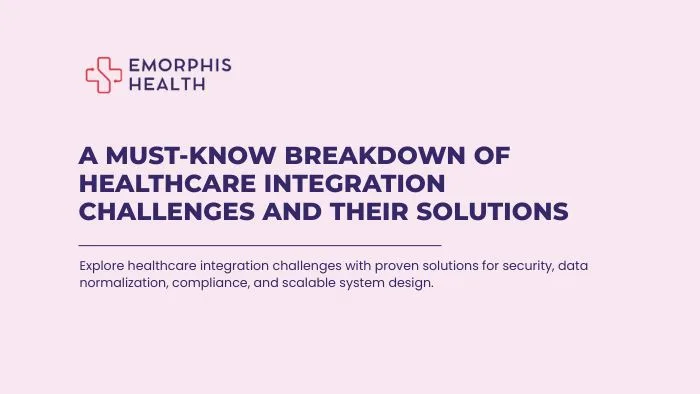Introduction to Healthcare Interoperability Standards
See Contents
- 1 Introduction to Healthcare Interoperability Standards
- 2 Evolution and Importance of Interoperability Standards
- 3 Key Healthcare Interoperability Standards
- 4 HL7 (Health Level Seven) and Its Role
- 5 FHIR (Fast Healthcare Interoperability Resources) standards
- 6 CDA (Clinical Document Architecture) and Its Significance
- 7 CCD (Continuity of Care Document) Standard
- 8 DICOM (Digital Imaging and Communications in Medicine) Standard
- 9 SNOMED CT (Systematized Nomenclature of Medicine Clinical Terms)
- 10 Role of IHE (Integrating the Healthcare Enterprise) in Standards
- 11 Conclusion: Advancing Healthcare through Interoperability Standards
In the dynamic realm of healthcare, the effective exchange of information across diverse systems is paramount for delivering optimal patient care. In fact, this synergy is made possible through the adoption of healthcare interoperability standards, a linchpin in the modernization of healthcare systems.
At the heart of healthcare interoperability is the commitment to breaking down silos and also fostering a cohesive environment where disparate systems seamlessly communicate. Our journey of comprehensive guide to healthcare interoperability standards begins with understanding the fundamental concepts that underpin this transformative landscape.
Why does Healthcare Interoperability matter?
Healthcare interoperability refers to the ability of different healthcare information technology systems and software applications to exchange, interpret, also use data cohesively. In fact, it is the cornerstone upon which the future of healthcare innovation is built. Moreover, it promises enhanced collaboration among healthcare providers, improved patient outcomes, and streamlined operational workflows.
The Need for Standardization
In the vast ecosystem of healthcare, various systems, applications, also devices generate a plethora of data. Without standardized protocols, this wealth of information remains trapped in isolated pockets. Furthermore, it hinders the comprehensive view required for informed decision-making. Healthcare Interoperability standards provide the common language necessary for these diverse components to communicate effectively. Moreover, transcending barriers and ensuring a unified healthcare landscape.
Evolution and Importance of Interoperability Standards
The landscape of healthcare has undergone a remarkable evolution over the years. In fact, one of the pivotal drivers of this transformation is the evolution of healthcare interoperability standards. Let us explore the roots, the milestones, also the ever-growing importance of healthcare interoperability standards in shaping the present and future of healthcare.
Evolution: A Historical Perspective
The concept of interoperability in healthcare has evolved alongside advancements in technology and also a growing recognition of the need for cohesive data exchange. In fact, early attempts at standardization were characterized by disparate systems, incompatible formats, and limited connectivity. The journey toward true healthcare interoperability began as pioneers sought common ground to bridge these gaps.
Milestones in the Healthcare Interoperability Journey
- Standardized Messaging Protocols: The emergence of standards like Health Level Seven (HL7) laid the foundation for standardized messaging, allowing healthcare systems to communicate more effectively.
- Introduction of DICOM: In the realm of medical imaging, the Digital Imaging and Communications in Medicine (DICOM) standard revolutionized the exchange of medical images, fostering collaboration among different imaging devices.
- Shift to Electronic Health Records (EHR): The widespread adoption of EHR systems propelled the need for more comprehensive interoperability standards, giving rise to standards like Clinical Document Architecture (CDA) and Continuity of Care Document (CCD).
- Fast Healthcare Interoperability Resources (FHIR): FHIR emerged as a modern and flexible standard, adapting to the evolving needs of healthcare in the digital age. Its RESTful approach and focus on simplicity have positioned it as a key player in advancing interoperability.
Importance in the Modern Healthcare Landscape
- Enhanced Patient Care: Healthcare Interoperability standards facilitate a holistic view of patient data, also allowing healthcare providers to access comprehensive medical histories. In fact, this accessibility is pivotal in making informed decisions, reducing redundancies, and ultimately improving patient outcomes.
- Streamlined Operations: By fostering seamless communication between disparate systems, healthcare interoperability standards streamline operational workflows. Moreover, this not only enhances efficiency but also reduces the burden on healthcare professionals, allowing them to focus more on patient care.
- Data-driven Decision Making: In an era where data is king, healthcare interoperability standards empower healthcare organizations in fact, with the ability to harness the power of data. The standardized exchange of information also enables data-driven decision-making, leading to more informed strategies and policies.
- Interconnectivity for Public Health Initiatives: Healthcare Interoperability extends beyond individual healthcare settings. In fact, it plays a crucial role in supporting public health initiatives by enabling the aggregation and analysis of data on a broader scale, fostering collaboration and insights that can benefit entire communities.
As we reflect on the evolution and importance of healthcare interoperability standards. In fact, it becomes evident that they are not just technological frameworks but catalysts for positive change in healthcare. Moreover, the journey continues as we strive for even greater cohesion, connectivity, and innovation in the pursuit of a healthier world.
Explore the world of Integrated Health Solutions and its significance in modern healthcare.
Key Healthcare Interoperability Standards
In the intricate tapestry of modern healthcare, the seamless exchange of information is critical for delivering comprehensive and patient-centered care. In fact, key healthcare interoperability standards serve as the foundational building blocks. Moreover, it creates bridges that connect disparate systems and ensure a cohesive flow of data. Let’s delve into the essential standards shaping the digital healthcare landscape.
1. Health Level Seven (HL7)
- Overview: HL7 is a globally recognized standard for exchanging electronic health information. It provides a framework for the integration, sharing, also retrieval of clinical and administrative data.
- Significance: Widely used for interoperability, HL7 is instrumental in standardizing messaging formats, also facilitating the efficient communication of health data across different systems.
2. Fast Healthcare Interoperability Resources (FHIR)
- Overview: FHIR is a modern and flexible standard designed for the electronic exchange of healthcare information. In fact, its RESTful architecture allows for easy implementation and adaptability.
- Significance: FHIR addresses the need for agility in healthcare data exchange, supporting real-time communication also enabling the development of user-friendly applications.
3. Clinical Document Architecture (CDA)
- Overview: CDA is an XML-based standard for the exchange of clinical documents, ensuring the consistent representation of patient information across diverse healthcare systems.
- Significance: Commonly used in the creation of electronic health records (EHRs), CDA promotes interoperability by providing a standardized structure for clinical documents.
4. Continuity of Care Document (CCD)
- Overview: CCD is a standard that defines the structure also the semantics of a patient summary document. In fact, it promotes the exchange of essential health information during transitions of care.
- Significance: CCD facilitates interoperability by offering a standardized format for sharing crucial patient data, also supporting coordinated and continuous care.
5. Digital Imaging and Communications in Medicine (DICOM)
- Overview: DICOM is a widely adopted standard for the storage, exchange, also retrieval of medical images. In fact, it ensures compatibility and consistency in the representation of imaging data.
- Significance: In the realm of medical imaging, DICOM promotes healthcare interoperability among different imaging devices and healthcare systems, also enabling seamless collaboration.
6. Systematized Nomenclature of Medicine Clinical Terms (SNOMED CT)
- Overview: SNOMED CT is a comprehensive clinical terminology system that standardizes the naming of clinical concepts and also supports the exchange of health information.
- Significance: SNOMED CT enhances interoperability by providing a shared language for describing medical conditions, procedures, also observations across healthcare domains.
These key healthcare interoperability standards form the backbone of the interconnected healthcare landscape. By adhering to these standards, in fact, healthcare organizations can ensure that crucial information flows seamlessly. Also, it fosters collaboration, enhancing patient care, and driving innovation in the ever-evolving digital healthcare era.
HL7 (Health Level Seven) and Its Role
In the intricate web of healthcare information exchange, HL7 (Health Level Seven) stands out as a beacon of standardization. In fact, facilitates healthcare interoperability and harmonizes the communication between diverse healthcare systems. Let’s delve into the significance of HL7 also the pivotal role it plays in the ever-evolving landscape of healthcare data exchange.
Understanding HL7
- The Framework: HL7 is not just a standard; it’s a comprehensive framework for the exchange, integration, sharing, also retrieval of electronic health information. As a matter of fact, developed by the international organization Health Level Seven International. HL7 provides a set of protocols, methodologies, also standards to achieve these objectives.
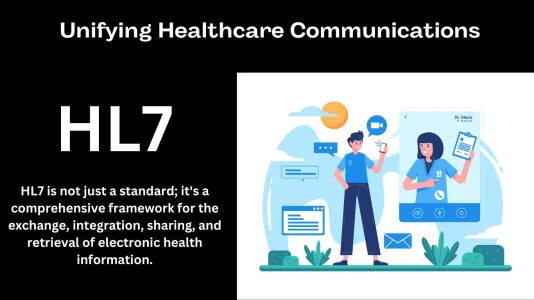
HL7 in Action
- Standardized Messaging Formats – Interoperability Backbone: HL7 is the backbone of Healthcare Interoperability. In fact, defining messaging standards that allow different healthcare applications and systems to communicate seamlessly. Also, these standardized formats ensure a common language for transmitting critical health information.
- Clinical Document Architecture (CDA) – Structured Documentation: HL7’s Clinical Document Architecture (CDA) standardizes the structure also semantics of clinical documents. It ensures that diverse healthcare systems can create, share, also interpret clinical documents consistently.
- Fast Healthcare Interoperability Resources (FHIR) – Modern Adaptability: HL7 FHIR, a newer addition to the HL7 family, is designed for the modern healthcare landscape. In fact, with a RESTful approach, FHIR enables easier implementation and adaptability, fostering real-time communication and data exchange.
- Supporting Healthcare Workflows – Enhanced Clinical Workflows: HL7 supports the seamless flow of information across different healthcare settings. From admissions to diagnostics and treatment, HL7 ensures that clinical workflows are not hindered by data silos, allowing for more efficient and patient-centered care.
The Role of HL7 in Interoperability
- Overcoming Data Silos: In a world where healthcare data resides in disparate systems, HL7 acts as a unifying force. In fact, by standardizing data formats and defining communication protocols, HL7 enables healthcare interoperability. Furthermore, breaking down data silos and ensuring that information flows cohesively.
- Ensuring Data Consistency: HL7 plays a crucial role in ensuring data consistency across different healthcare applications. In fact, providing a standardized framework minimizes discrepancies in how health data is represented, interpreted, and exchanged.
- Facilitating Global Collaboration: As a globally recognized standard, as a matter of fact, HL7 fosters collaboration on an international scale. Healthcare organizations worldwide can leverage HL7 to communicate and share health information, also contributing to a more interconnected and collaborative global healthcare landscape.
In essence, HL7 serves as a linchpin in the journey towards seamless healthcare communication. In fact, its role in standardizing messaging formats and supporting clinical workflows ensures data consistency. Also, it underscores its significance as a foundational element in the pursuit of healthcare interoperability and enhanced patient care.
FHIR (Fast Healthcare Interoperability Resources) standards
In the rapidly advancing landscape of healthcare technology. FHIR, or Fast Healthcare Interoperability Resources, emerges as a beacon of innovation. In fact, it offers a modern and flexible approach to data exchange. Let’s unravel the significance of FHIR and also explore how this standard is reshaping the way healthcare information is shared, accessed, and utilized.
Understanding FHIR
- Redefining Interoperability: FHIR is not just a standard; it’s a paradigm shift in how healthcare data interoperability is approached. Developed by Health Level Seven International (HL7), FHIR is designed to be agile, adaptable, also reflective of the current needs of the healthcare industry.
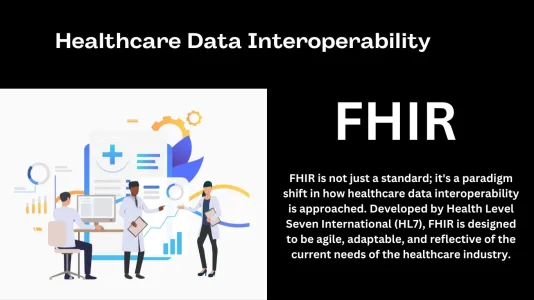
Key Features and Components of FHIR
- RESTful Architecture – Simplified Integration: FHIR employs a RESTful API (Application Programming Interface) architecture, simplifying integration and also making it more accessible for developers. In fact, this approach aligns with modern web development practices, fostering ease of implementation and adoption.
- Resource-based Data Model – Granular Data Representation: FHIR utilizes a resource-based data model, allowing for a granular representation of healthcare information. Each resource represents a discrete element, such as a patient’s demographics, medications, or diagnostic reports, also making it easy to manage and exchange specific pieces of information.
- Modularity and Extensibility – Tailored Solutions: FHIR’s modular structure allows for the creation of tailored solutions. Healthcare organizations can build on existing resources or extend them to meet their specific needs, fostering adaptability to diverse use cases and evolving requirements.
- Support for Modern Web Standards – Integration with Web Technologies: FHIR leverages modern web standards such as JSON (JavaScript Object Notation) and XML (eXtensible Markup Language) for data exchange. This compatibility ensures that FHIR seamlessly integrates with contemporary web technologies, facilitating widespread implementation.
FHIR in Action
- Enhanced Patient Engagement – Empowering Patients: FHIR’s user-friendly design facilitates patient engagement. In fact, this is done by enabling individuals to access and share their health data across different platforms and applications. Moreover, this empowerment contributes to more informed decision-making and collaborative healthcare.
- Interoperability Across Systems – Breaking Down Data Silos: FHIR addresses the challenge of data silos by providing a standardized and interoperable framework. In fact, its RESTful APIs facilitate the smooth exchange of healthcare information across different systems, ensuring a more connected and collaborative healthcare ecosystem.
- Innovation in Healthcare Applications – Catalyst for Innovation: FHIR serves as a catalyst for innovation in healthcare applications. Moreover, developers can leverage FHIR’s modular structure and modern design to create cutting-edge solutions, from mobile health apps to advanced analytics platforms.
In summary, FHIR is not merely a standard; it’s a dynamic force driving healthcare interoperability into the future. In fact, its RESTful architecture, resource-based data model, and support for modern web standards position FHIR as a pivotal enabler of connectivity. Also, adaptability, and innovation in the ever-evolving landscape of healthcare technology.
Check more details on How to get started with FHIR Implementation.
CDA (Clinical Document Architecture) and Its Significance
In the intricate tapestry of healthcare data exchange, CDA, or Clinical Document Architecture, emerges as a cornerstone. Moreover, it provides a standardized framework for the structured representation of clinical documents. Let’s delve into the significance of CDA and how this standard plays a pivotal role in ensuring a coherent and meaningful exchange of critical patient information.
Understanding CDA
- Structured Clinical Documentation: CDA is an XML-based standard developed by Health Level Seven International (HL7). In fact, it is designed to facilitate the exchange of clinical documents among different healthcare systems. Unlike traditional unstructured documents, CDA ensures that clinical information is structured and easily interpretable.
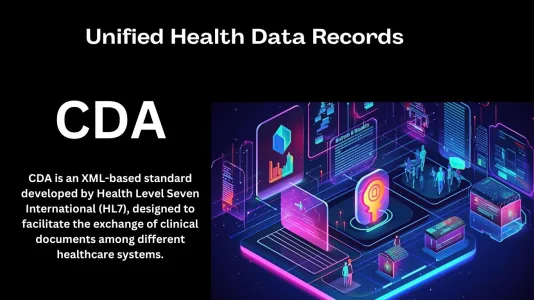
Key Components and Features of CDA
- Standardized Document Structure – Consistent Representation: CDA ensures a consistent structure for clinical documents, enabling healthcare providers to create, share, and interpret information in a standardized manner. This consistency is crucial for reducing ambiguity and enhancing the overall quality of patient data.
- Clinical Information Categorization – Granular Information Representation: CDA allows for the granular categorization of clinical information, making it possible to represent specific data elements such as medications, allergies, procedures, and vital signs in a standardized format. This detailed representation enhances the comprehensiveness of clinical documents.
- Human-Readable and Machine-Processable – Dual Accessibility: One of the distinctive features of CDA is its ability to be both human-readable and machine-processable. Healthcare professionals can easily interpret and comprehend the content, while electronic systems can extract, analyze, and exchange data efficiently.
- Support for Multiple Types of Documents – Versatility in Document Types: CDA is versatile and supports various types of clinical documents, including discharge summaries, progress notes, and diagnostic reports. This versatility ensures that the standard can be applied across diverse healthcare scenarios.
CDA in Action
- Enhanced Continuity of Care – Seamless Transitions: CDA plays a vital role in ensuring the continuity of care during patient transitions between different healthcare settings. In fact, by providing a standardized format for clinical documents, CDA facilitates the smooth exchange of information, reducing the risk of data loss or misinterpretation.
- Facilitating Interoperability – Breaking Down Information Silos: CDA acts as a bridge in the quest for healthcare interoperability, also breaking down information silos by offering a common language for exchanging clinical information. This interoperability is instrumental in creating a connected healthcare ecosystem.
- Supporting Electronic Health Records (EHRs) – Structured EHRs: CDA is widely employed in the creation and exchange of Electronic Health Records (EHRs). In fact, by structuring patient information in a standardized format, CDA contributes to the development of comprehensive and interoperable EHR systems.
In essence, CDA is a linchpin in the structured exchange of clinical information. Its significance lies not only in providing a standardized framework for representing diverse clinical documents but also in fostering continuity of care. Moreover, enhancing interoperability, and supporting the evolution of electronic health records. Henceforth, CDA stands as a testament to the commitment to precision and clarity in the ever-evolving landscape of healthcare data management.
CCD (Continuity of Care Document) Standard
In the intricate tapestry of healthcare data exchange, the Continuity of Care Document (CCD) standard emerges as a crucial element. Also, designed to facilitate the structured sharing of essential patient information. Let’s delve into the significance of CCD and its pivotal role in ensuring the seamless continuity of care across diverse healthcare settings.
Understanding CCD
- A Framework for Interoperability: CCD is an industry-standard markup language developed by Health Level Seven International (HL7). It provides a structured and standardized format for documenting also exchanging patient summary information, promoting interoperability between different healthcare systems.
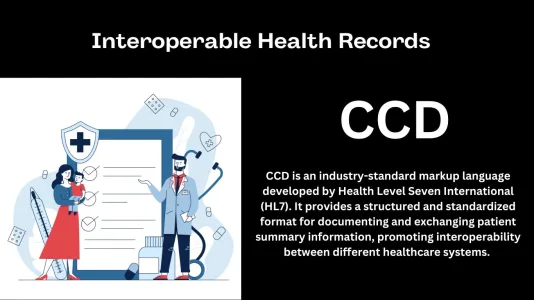
Key Components and Features of CCD
- Patient-Centric Summary – Holistic Information Representation: CCD is structured to encapsulate a comprehensive summary of a patient’s health information. It includes key data elements such as allergies, medications, also problem lists, procedures, and vital signs, presenting a holistic view of the patient’s health status.
- Human-Readable and Machine-Processable – Accessibility for All: One of CCD’s notable features is its dual accessibility. In fact, it is designed to be both human-readable and machine-processable. This ensures that healthcare professionals also can easily interpret the document while allowing electronic systems to efficiently process and exchange the data.
- Consistent Information Exchange – Standardized Data Format: CCD enforces a standardized data format, facilitating consistent information exchange. In fact, this standardization is instrumental in reducing errors, improving data accuracy, and ensuring that healthcare information is conveyed uniformly across different systems.
- Structured for Care Coordination – Enhanced Care Collaboration: CCD is particularly valuable during transitions of care, such as patient referrals or handovers between different healthcare providers. In fact, its structured format supports effective care coordination by providing a concise yet comprehensive snapshot of the patient’s health history.
CCD in Action
- Facilitating Interoperability – Seamless Data Exchange: CCD plays a pivotal role in fostering healthcare interoperability by providing a common language for the exchange of patient summary information. In fact, this common ground is essential for bridging the gaps between disparate healthcare systems and promoting a more connected healthcare ecosystem.
- Supporting Transitions of Care – Smooth Handovers: During transitions of care, such as when a patient moves from a hospital to a primary care setting, CCD ensures a smooth handover of essential health information. Moreover, this promotes continuity of care and reduces the risk of information gaps.
- Enabling Patient-Cantered Care – Empowering Patients: CCD empowers patients by providing them with a consolidated summary of their health information. In fact, this patient-centric approach enhances patient engagement, enabling individuals to actively participate in their care and make informed decisions.
In essence, CCD stands as a linchpin in the quest for seamless healthcare information continuity. Its structured format, dual accessibility, also focus on healthcare interoperability make it a valuable asset in the modern healthcare landscape. As we navigate the complexities of healthcare data exchange, CCD stands as a testament to the commitment to enhancing patient care through standardized and also comprehensive information sharing.
DICOM (Digital Imaging and Communications in Medicine) Standard
In the realm of medical imaging, the Digital Imaging and Communications in Medicine (DICOM) standard shines as a beacon of uniformity. Moreover, it ensures the seamless exchange, storage, and interpretation of medical images across diverse healthcare systems. Let’s delve into the significance of DICOM and also its pivotal role in shaping the landscape of medical imaging.
Understanding DICOM
- A Common Language for Medical Imaging: DICOM is a comprehensive standard developed by the American College of Radiology (ACR) and the National Electrical Manufacturers Association (NEMA). As a matter of fact, it provides a framework for the consistent representation and communication of medical images and associated information.

Key Components and Features of DICOM
- Universal Image Format – Interoperability at its Core: DICOM establishes a universal format for medical images, also ensuring that images from different modalities and manufacturers can be uniformly interpreted. Moreover. this healthcare interoperability is fundamental for creating a cohesive and interconnected medical imaging environment.
- Metadata for Enriched Information – Beyond Images: DICOM not only standardizes image formats but also includes metadata—information about the image. Furthermore, this metadata encompasses patient information, imaging parameters, acquisition techniques, and other details, enriching the context of the medical image.
- Structured Communication – Streamlined Data Exchange: DICOM defines a structured approach to communication. In fact, it allows medical images and associated information to be exchanged seamlessly between different imaging devices and healthcare systems. This ensures the integrity and consistency of image data during transmission.
- Storage and Retrieval Standards – Efficient Data Management: DICOM establishes standards for the storage and also retrieval of medical images. In fact, this ensures that images are stored in a consistent manner, facilitating efficient retrieval for diagnosis, treatment planning, and long-term archiving.
DICOM in Action
- Multi-Modality Collaboration – Integration Across Modalities: DICOM plays a pivotal role in integrating images from various medical modalities, including X-ray, MRI, CT scans, also ultrasound. In fact, this seamless collaboration allows healthcare professionals to access a comprehensive array of imaging data for more accurate diagnoses.
- Telemedicine Advancements – Enabling Remote Consultations: DICOM’s standardized image format is essential for telemedicine applications. In fact, it enables the secure and standardized transmission of medical images, supporting remote consultations, second opinions, and collaborations between healthcare professionals.
- Research and Education – Archiving for Future Insights: DICOM’s standards for storage and retrieval contribute to the creation of comprehensive image archives. Moreover, these archives serve as valuable resources for research, education, also ongoing advancements in medical imaging technology.
- Global Standardization – International Acceptance: DICOM’s widespread adoption on a global scale ensures that medical images can be shared and also interpreted consistently across international borders. In fact, this international standardization is essential for collaborative research, global healthcare initiatives, and the sharing of best practices.
In essence, DICOM stands as a cornerstone in the world of medical imaging. Its universal image format, and structured communication, also support healthcare interoperability. Moreover, this empowers healthcare professionals with the tools they need for accurate diagnoses, effective treatment planning, and collaborative research. In fact, as medical imaging continues to evolve, DICOM remains a linchpin, providing a standardized language that transcends boundaries and enhances the quality and accessibility of healthcare.
SNOMED CT (Systematized Nomenclature of Medicine Clinical Terms)
In the intricate landscape of healthcare terminology, SNOMED CT (Systematized Nomenclature of Medicine Clinical Terms) emerges as a powerful and comprehensive language. Designed to provide a standardized and precise way of representing clinical information, SNOMED CT plays a pivotal role in enhancing communication, interoperability, and the overall understanding of healthcare data.
Understanding SNOMED CT
- A Global Clinical Terminology: SNOMED CT is a multilingual clinical healthcare terminology that systematically represents the diverse aspects of clinical information. Developed and maintained by SNOMED International, it serves as a standardized language for accurately recording, sharing, and analyzing health information across various healthcare systems and disciplines.
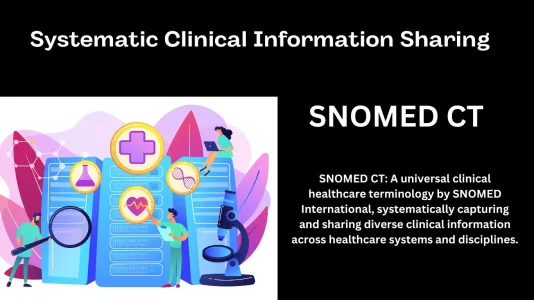
Key Components and Features of SNOMED CT
- Concept-Oriented Structure – Granular Concept Representation: SNOMED CT adopts a concept-oriented approach, allowing for the granular representation of clinical concepts. Each concept represents a unique clinical idea, providing a foundation for consistent and precise communication.
- Hierarchy and Relationships – Structured Conceptual Framework: SNOMED CT organizes concepts hierarchically, establishing relationships between them. This structured framework enables the representation of broader concepts and their detailed subtypes, fostering a comprehensive understanding of clinical information.
- Clinical Definitions – Defining Clinical Entities: SNOMED CT provides clinical definitions for each concept, ensuring clarity in the interpretation of terms. These definitions help healthcare professionals, researchers, and systems understand the meaning and context of each clinical concept.
- Multilingual Support – Global Accessibility: SNOMED CT is designed to be multilingual, supporting the diverse linguistic needs of the global healthcare community. This feature ensures that healthcare information can be accurately represented and shared across different languages and regions.
SNOMED CT in Action
- Interoperability and Data Consistency – Common Language for Integration: SNOMED CT serves as a common language for integrating clinical information across disparate healthcare systems. Its standardized representation enhances data consistency, supporting interoperability and facilitating a cohesive view of patient information.
- Enhanced Clinical Documentation – Precision in Electronic Health Records (EHRs): SNOMED CT is widely used in electronic health records (EHRs) to facilitate precise and standardized clinical documentation. This ensures that healthcare information is consistently recorded, leading to improved accuracy and reliability.
- Clinical Decision Support – Facilitating Informed Decision-Making: SNOMED CT contributes to clinical decision-support systems by providing a structured vocabulary for representing clinical concepts. This support aids healthcare professionals in making informed decisions based on standardized and well-defined information.
- Research and Analytics – Enabling Meaningful Analysis: SNOMED CT’s detailed representation of clinical concepts supports meaningful analysis and research. Researchers can leverage this standardized terminology to extract valuable insights from healthcare data, driving advancements in medical knowledge and practice.
In summary, SNOMED CT stands as a cornerstone in the realm of clinical terminology. Its concept-oriented structure, hierarchical organization, and multilingual support contribute to the precision and standardization of healthcare information. As healthcare systems strive for interoperability and global collaboration, SNOMED CT remains a vital tool in ensuring that clinical data is accurately represented, shared, and understood across the diverse landscape of modern healthcare.
Read the details of Top 10 Mistakes You Should Avoid In Healthcare Integration
Role of IHE (Integrating the Healthcare Enterprise) in Standards
In the ever-evolving landscape of healthcare, the Integrating the Healthcare Enterprise (IHE) initiative stands as a catalyst for interoperability, playing a crucial role in bridging the gaps between diverse healthcare systems and standards. Let’s explore the significant role that IHE plays in promoting seamless integration and collaboration within the healthcare domain.
Understanding IHE
- Bridging the Interoperability Gap: IHE is an initiative that brings together healthcare professionals, industry experts, and technology vendors to address the challenges of interoperability. Established by healthcare professionals and industry stakeholders, IHE works to improve the way computer systems in healthcare share information.
Key Components and Features of IHE
- Profiles for Interoperability – Guiding Implementation: IHE develops profiles that serve as implementation guides. These profiles define specific use cases and guide the implementation of standards to address interoperability challenges in clinical workflows. They provide a practical roadmap for healthcare organizations to achieve seamless integration.
- Integration of Standards – Harmonizing Standards: IHE is instrumental in harmonizing various healthcare standards, including those developed by organizations such as HL7, DICOM, and others. By aligning and integrating these standards, IHE facilitates a more cohesive and unified approach to healthcare data exchange.
- Testing and Demonstrations – Ensuring Conformance: IHE conducts testing and demonstrations to ensure that healthcare systems and applications conform to established standards and profiles. This rigorous testing process validates the interoperability of solutions and promotes the adoption of standardized practices.
- Clinical Use Cases – Addressing Real-World Challenges: IHE focuses on addressing real-world challenges faced by healthcare organizations through the development of clinical use cases. These use cases guide the implementation of standards to solve specific interoperability problems encountered in clinical practice.
Check the details on Healthcare Interoperability – Key Challenges and Resolutions
IHE in Action
- Enhanced Interoperability – Seamless Communication: IHE’s work on profiles and implementation guides facilitates seamless communication between different healthcare systems. This interoperability is crucial for ensuring that critical patient information can be exchanged accurately and efficiently.
- Efficient Data Exchange – Optimizing Clinical Workflows: IHE’s emphasis on clinical use cases helps optimize clinical workflows by providing standardized solutions for common challenges. This, in turn, promotes efficient data exchange and enhances the overall effectiveness of healthcare delivery.
- Vendor Neutrality – Enabling Vendor-Neutral Solutions: IHE’s efforts contribute to the development of vendor-neutral solutions. By providing guidelines and profiles that are independent of specific vendors, IHE ensures that healthcare organizations have the flexibility to choose interoperable solutions that best suit their needs.
- Global Collaboration – International Impact: IHE’s initiatives have a global impact, fostering collaboration across international borders. By providing a framework for interoperability that transcends geographical boundaries, IHE contributes to the development of a connected and collaborative global healthcare ecosystem.
In essence, IHE serves as a linchpin in the pursuit of interoperability within the healthcare domain. Its focus on practical implementation guides, testing processes, and addressing real-world challenges positions IHE as a driving force in harmonizing standards and promoting seamless integration. As healthcare continues to advance, IHE remains a key ally in ensuring that technology solutions work together harmoniously to improve patient care, enhance clinical workflows, and drive innovation in the healthcare industry.
Conclusion: Advancing Healthcare through Interoperability Standards
In the dynamic landscape of healthcare, the role of interoperability standards is paramount, serving as the linchpin for transformative advancements. As we navigate the complexities of modern healthcare delivery, the integration and harmonization of standards play a pivotal role in fostering seamless communication, optimizing workflows, and ultimately enhancing patient care.
Facilitating Seamless Communication
Interoperability standards, such as HL7, FHIR, CDA, CCD, DICOM, and SNOMED CT, serve as a universal language that transcends the boundaries of diverse healthcare systems. By providing a common ground for the exchange of clinical information, these standards enable seamless communication between disparate systems, breaking down information silos and ensuring that critical patient data flows cohesively.
Optimizing Clinical Workflows
The application of interoperability standards is not merely a technical necessity but a catalyst for optimizing clinical workflows. Standards, guided by organizations like IHE, offer implementation profiles and use cases that address real-world challenges. This optimization leads to more efficient data exchange, streamlined processes, and improved collaboration among healthcare professionals.
Enhancing Patient Car
At the heart of interoperability standards is a commitment to enhancing patient care. By providing a standardized framework for representing clinical concepts, these standards empower healthcare professionals with accurate and comprehensive information. This, in turn, contributes to informed decision-making, improved treatment outcomes, and a patient-centric approach to healthcare delivery.
Fostering Innovation
Interoperability standards are the enablers of innovation in healthcare. As technology continues to evolve, these standards provide a foundation upon which new solutions and applications can be built. From medical chatbots to advanced analytics platforms, interoperability standards create an environment that fosters creativity, collaboration, and the development of cutting-edge tools.
Global Collaboration for a Connected Ecosystem
The impact of interoperability standards extends beyond individual healthcare settings, fostering global collaboration. Whether it’s the adoption of DICOM for standardized medical imaging or the use of SNOMED CT for multilingual representation of clinical terms, these standards contribute to a connected and collaborative global healthcare ecosystem.
In conclusion, the journey of advancing healthcare through interoperability standards is a testament to the industry’s commitment to precision, collaboration, and patient-centric care. As we move forward, it is imperative to continue embracing and evolving these standards to meet the ever-changing needs of healthcare delivery. By doing so, we not only pave the way for technological innovation but also ensure that every patient receives the highest standard of care in a seamlessly interconnected healthcare landscape.
Connect with us for more details.

